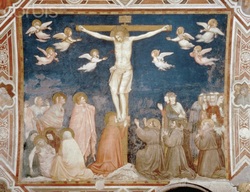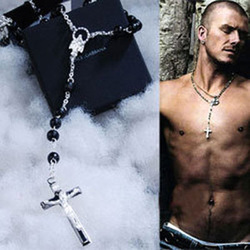Religion and Fashion: Chrisitanity Hits The Catwalk
Christianity in pop culture is not a new concept....

Should we be shocked to see people wearing t-shirts with pictures depicting Jesus Christ, or runway models wearing Rosary Beads as fashion accessories? Well, that is ones own personal choice, but christianity has been immersed in popular culture for thousands of years. We can see this in the vast number of Frescos, paintings, prints, and figurines that have been in mass production for a very long time.
It would seem that it is ok for Jesus to be portrayed in popular hollywood movies, so why not high fashion? They are both artistic forms of expression, so why would wearing a Virgin Mary shirt be any different than watching The Passion of the Christ?
By approaching Christianity through pop culture and fashion we can learn more about the widespread perceptions of religion and the role it plays in the everyday lives of people. An analysis of pop culture can also provide us with insights about how religions change and are changed by the cultures that surround them. (Religion and Popular Culture in America,2005) The early 1990s became the decade that introduced such garments to society. "the beginning of the 1990s saw the intrest of religious symbols into clothing design." (Material Culture, 1995)
It would seem that it is ok for Jesus to be portrayed in popular hollywood movies, so why not high fashion? They are both artistic forms of expression, so why would wearing a Virgin Mary shirt be any different than watching The Passion of the Christ?
By approaching Christianity through pop culture and fashion we can learn more about the widespread perceptions of religion and the role it plays in the everyday lives of people. An analysis of pop culture can also provide us with insights about how religions change and are changed by the cultures that surround them. (Religion and Popular Culture in America,2005) The early 1990s became the decade that introduced such garments to society. "the beginning of the 1990s saw the intrest of religious symbols into clothing design." (Material Culture, 1995)
Christianity and Material Culture

Material Christiany is considered profane to some scholars. But it is apparent everywhere we go, as can be seen by clothing products people wear to the "What would Jesus Do?" bracelets seen in large departmen stores. ( God in the Details: American Religion in Popular Culture, 2001) In popular culture, religious paraphernalia does not symbolize or repersent sanctity as it used to. Such objects like the cruscifix, statues of Jesus and rosary beads have lost their meanifulness to some religious critics, as well as some Christians themselves. The shift in pop culture due to technology, and the percieved 'norms' of religion and elite culture are radically changing. New sub-cultures are beginningto emerge . "During thefirst half of the twentieth century, cultural crititcs observed that a powerful "cultural industry" made up of the media, popular arts, entertainment and fashion controlled the desires and needs of the masses." (Material Christianity, pg10) These masses have altered the meaningfullness behind religious symbols and have put them in a context that has allowed them to be seen as trendy. The change of meaning in these artifacts begain after the second Vatican council simplifed public worship. The religious goods insdustry found that the items didn't sell as much. These objects and symbols have attained different meanings because of the changing of relationships between people and religion. Christianity is not taken as serious as it once was. The images are now seen as excotic and are now considered "style". (Material Culture) The continual shift in society and its beliefs is a constant changeable force, and the meanings of christian materials in the 21st centuary is not as sacred. "I am not drawn to critiicize christians who use Lourdes water or who wears "praise the lord" T-shirts, I reject, however, the opinion of those who find nothing signifigant in these religious getstures." ( Material Culture, pg12)
